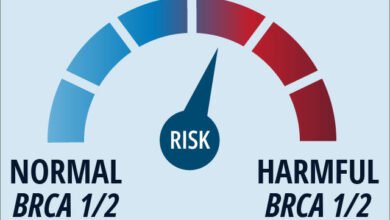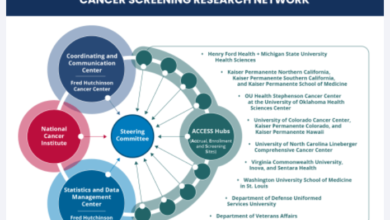Cancer Research UK – Science blog

You may have seen a big focus on lung cancer in the headlines recently.
From how we’re one step closer to learning why advanced cancer causes sudden weight loss, to how lung cancer has the ‘infinite’ ability to evolve.
That’s because TRACERx – our flagship lung cancer study – recently published 7 papers highlighting new findings that help us to understand more about how lung cancer evolves and spreads.
TRACERx is a collaboration of experts all working together to investigate how lung cancer progresses and why treatments sometimes stop working. And that’s important, because lung cancer is the third most common cancer in the UK, with around 48,500 people diagnosed each year.
These new results have been years in the making. TRACERx has been tracking people with non-small cell lung cancer (NSCLC) for 9 years, carefully examining how tumours change over time, how they spread and how this can affect clinical outcomes.
So we’ve been delving into some of these new findings and what they mean for the future of lung cancer research and treatment.
Predicting when lung cancer might spread
As we summarised in our last article, some of the recent papers from TRACERx have shown that by looking at tumour evolution – and the different populations of cancer cells that can form as the tumour grows, called subclones – we can predict how likely a cancer is to return and whether it might spread (also known as metastasise).
But the difficultly with this is that obtaining the cancer cells to identify specific subclones usually requires a sample of the tumour. This is generally done either during surgery or through a procedure known as a biopsy, where a small piece of tissue it taken.
As Dr Christopher Abbosh, a researcher based at the UCL Cancer Institute and joint lead author on one of the recent papers, puts it:
“Currently, the best option we have to monitor a patient’s tumour is to extract tissue either through a biopsy or during surgery. Both are invasive and time-consuming options which give us a limited snapshot as to how that tumour is behaving at a given point in time.”
So not only are these methods of cell collection ‘invasive’, which can often be uncomfortable or time consuming, they are also unable to give us a clear picture of how a tumour is changing over time.
But in one of their recently published papers, TRACERx researchers may have found a new way to track changes in a tumour and see how likely it is to spread, by looking at blood samples.
Looking for clues in blood
As a tumour grows, cells die and are replaced by new cells. These dead cells then get broken down and their contents, including their DNA, are released into the bloodstream. These chunks of tumour DNA in the blood are known as circulating tumour DNA (ctDNA).
In the past, our researchers have shown that measuring ctDNA in blood can be used to identify people who are at higher risk of their cancer returning.
And this recent research from TRACERx confirmed that finding. The researchers found that the presence of ctDNA in the blood after surgery suggested that the patient’s cancer was highly likely to return in the future.
Interestingly, the researchers also found that measuring ctDNA before surgery may be an indicator of poor clinical outcome. By measuring the types of cancer cell subclones in blood samples taken before surgery, they saw that subclones which were likely to cause future metastases had grown to become larger before surgery compared to non-metastatic subclones.
This could allow clinicians to identify people whose cancer is likely to return after surgery, meaning they could offer them treatment earlier.
“A blood test that reads ctDNA could allow doctors to track someone’s cancer in real time, allowing them to personalise treatments to that patient,” says Abbosh.
“Analysis of ctDNA would allow us to get a fuller picture of how the tumour is changing during the course of the patient’s disease using minimally invasive blood tests. It would also allow doctors to treat people more proactively, taking swift action to change a treatment plan that’s not working.”
Detecting the undetectable
But this study also took that a step further.
Heterogeneous tumours – tumours that are composed of multiple distinct subclones – are associated with poor disease outcome.
Tumour heterogeneity can be measured by calculating and estimating something called cancer cell fractions (CCFs). This is a measure of the relative proportions of different subclones in a sample and is what TRACERx researchers have been measuring in ctDNA.
But one of the problems with analysing ctDNA in the early stages of metastasis, when the cancer has just started spreading, is that ctDNA levels in the blood can be very low. So low that they are often undetectable.
To overcome this, TRACERx researchers have developed new technologies specifically designed to analyse blood samples with low ctDNA levels. The tool, called ECLIPSE, is able to estimate the CCF from low tumour content ctDNA.
And it seems to be able to do this accurately – the CCF estimates made by ECLIPSE from blood samples were proportional to measures of CCF from biopsies sampled at surgery.
But importantly, ECLIPSE was also able to identify patients whose metastasis contained multiple subclones, which they found was associated with poor clinical outcome.
Collecting tissues through biopsies at the early stages of relapse can be difficult. In the TRACERx cohort only 44% of relapse patients had a tissue sample obtained at relapse, but when using blood sampling in addition to tissue sampling the researchers were able to get good measures of subclone heterogeneity in 82% of relapse patients.
This means that by using ECLIPSE, it may be possible to identify people whose cancer has spread at the early stages of metastasis using just a blood test. This means that treatments might be able to be offered sooner, when they are often more effective, to more patients.
Getting a truer picture
As Abbosh explained, one of the main advantages of measuring ctDNA in the blood is that it can be used to monitor people with lung cancer in real time, rather than relying on tumour ‘snapshots’ from biopsies.
But measuring ctDNA could also be a good way of overcoming ‘sampling bias’ that may occur with biopsies.
When sampling from a biopsy, researchers are only able to get information about tumour cells that are present in that particular region of the tumour. But the types and frequencies of cells can vary hugely both across and between different tumours.
However, ctDNA may be released from several different regions of a tumour, and therefore give a truer picture of the subclones present within that tumour.
These findings show that collecting plasma samples along with a single tumour biopsy can help to overcome this ‘sampling bias’ and potentially increase the accuracy of clinical biomarker measurement.
Just the beginning
TRACERx researchers hope that, by using the methods they’ve developed, in the future it might be possible to predict the type of subclone that may cause a tumour recurrence at the time of surgery.
“We find that when a cancer comes back, it usually comes from a specific part of the original tumour, and if we knew in advance which part of tumour would come back we could focus our efforts more precisely on those cells to eliminate the disease more effectively,” said Alexander Frankell, senior research fellow at the Francis Crick Institute and joint lead author on the research paper.
“We’ve found evidence that this might be possible in the future using a blood test.”
This could mean that we could use blood tests to help inform treatment against the specific subclones that could lead to relapse.
And this is just the beginning.
TRACERx EVO is a new 7-year programme that will build on the findings from TRACERx, allowing us to uncover even more about how lung cancer evolves and evades treatment.
“The exciting results emerging from TRACERx improve our understanding that cancer is a disease which evolves as it progresses, meaning that late-stage cancers can become very hard to treat successfully,” said Dr David Crosby, head of prevention and early detection at Cancer Research UK.
“This underscores the crucial importance of further research to help us to detect cancers at the earliest stages of their development or even better, to prevent them from happening at all. Prevention and early detection are two major strategic priorities for Cancer Research UK, where ongoing investment is of the utmost importance in our mission to beat cancer.”
Source link
#Cancer #Research #Science #blog



